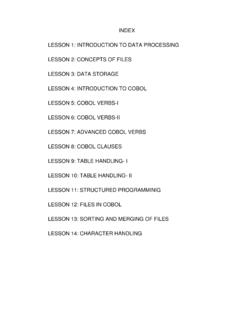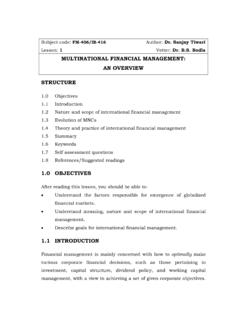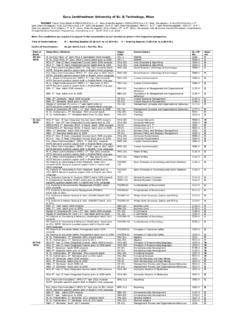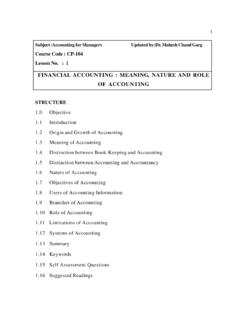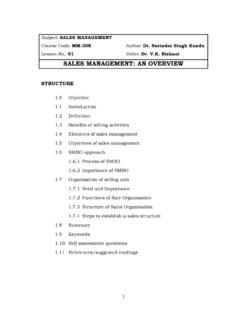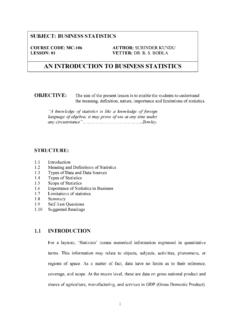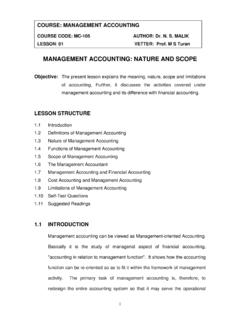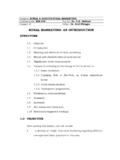Transcription of Lesson No: 1 Lesson Name : Overview of System Analysis ...
1 Objectives: Introduction Over View of System Analysis and Design Business System Concepts Characteristics of a System Elements of a System Types of Systems Systems Models Categories of Information Summary Questions Objectives Defining a System The role of computer in information systems What are the characteristic and element of information System What are the various types of information System and models What are the different types of specialised information System
2 Introduction In business, System Analysis and Design refers to the process of examining a business situation with the intent of improving it through better procedures and methods. System Analysis and design relates to shaping organizations, improving performance and achieving objectives for profitability and growth. The emphasis is on systems in action, the relationships among subsystems and their contribution to meeting a common goal. Lesson No: 1 Lesson Name : Overview of System Analysis & Design Author : Dr.
3 Jawahar Vetter: Prof. Dharminder Kumar Looking at a System and determining how adequately it functions, the changes to be made and the quality of the output are parts of System Analysis . Organizations are complex systems that consist of interrelated and interlocking subsystems. Changes in one part of the System have both anticipated and unanticipated consequences in other parts of the System . The systems approval is a way of thinking about the Analysis and design of computer based applications.
4 It provides a framework for visualizing the organizational and environmental factors that operate on a System . When a computer is introduced into an organization, various functions and dysfunction s operate on the user as well as on the organization. Among the positive consequences are improved performance and a feeling of achievement with quality information. Among the unanticipated consequences might be a possible threat to employees job, a decreased morale of personnel due to back of involvement and a feeling of intimidation by users due to computer illiteracy.
5 The analyst s role is to remove such fears and make the System a success. System Analysis and design focus on systems, processes and technology. Over View of System Analysis and Design Systems development can generally be thought of as having two major components: Systems Analysis and Systems design. System design is the process of planning a new business System or one to replace or complement an existing System . But before this planning can be done, we must thoroughly understand the old System and determine how computers can best be used to make its operation more effective.
6 System Analysis , then, is the process of gathering and interpreting facts, diagnosing problems, and using the information to recommend improvements to the System . This is the job of the systems analyst. Consider, for example, the stockroom operation of a clothing store. To better control its inventory and gain access to more up to date information about stock levels and reordering, the store asks a System analyst, to computerize its stockroom operations. Before one can design a System to capture data, update files, and produce reports, one needs to know more about the store operations: what forms are being used to store information manually, such as requisitions, purchase orders, and invoices and what reports are being produced and how they are being used.
7 To proceed, you then seek out information about lists of reorder notices, outstanding purchase orders, records of stock on hand, and other reports. You also need to find out where this information originates, whether in the purchasing department, stockroom, or accounting department. In other words, you must understand how the existing System works and, more specifically, what the flow of information through the System looks like. You also must know why the store wants to change its current operations.
8 Does the business have problems tracking orders, merchandise, or money? Does it seem to fall behind in handling inventory records? Does it need a more efficient System before it can expand operations? Only after you have collected these facts can you being to determine how and where a computer information System can benefit all the users of the System . This accumulation of information, called a systems study, must precede all other Analysis activities. Systems analysts do more than solve current problems.
9 They are frequently called upon to help handle the planned expansion of a business. In the case of the clothing store, the systems study is future oriented, since no System currently exists. Analysts assess as carefully as possible what the future needs of the business will be and what changes should be considered to meet these needs. In this instance and in most others, analysts may recommend alternatives for improving the situation. Usually more than one strategy is possible. Working with managers and employees in the organization, systems analysts recommend which alternative to adopt, based on such concerns as the suitability of the solution to the particular organization and setting, as well as the employee support the solution is likely to have.
10 Sometimes the time required to develop one alternative, compared with others, is the most critical issue. Costs and benefits are also important determinants. In the end, management, which will pay for and use the result, actually decides which alternative to accept. Once this decision is made, a plan is developed to implement the recommendation. The plan includes all systems design features, such as new data capture needs, file specifications, operating procedures, equipment and personnel needs.
